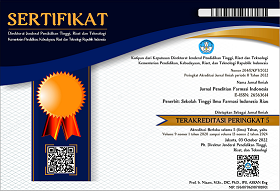Farmakokinetika dan Bioavailability Senyawa Golongan Santon Review Komprehensif
DOI:
https://doi.org/10.51887/jpfi.v8i2.780Keywords:
Bioavailability, Xanthone, PharmacokineticAbstract
The use of herbs for treating various ailment dates back several centuries. Evidence-based verification of the efficacy of Herbal medicines is still frequently lacking. Of particular interest is the question of bioavailability to assess to what degree and how fast compounds are absorbed after administration of herbal. Of further interest is the elucidation of metabolic pathways, and the assessment of elimination routes and their kinetics. These data become an important issue to link data from pharmacological assays and clinical effects. A better understanding of the pharmacokinetics and bioavailability of phytopharmaceuticals can also help in designing rational dosage regimens. To provide provide a detailed picture on ADME parameters (absorption, distribution, metabolism, and excretion) of some xanthone active compound, this article reviews the pharmacokinetic profile of 7 xanthones bioactive compound from the year 2009 onward.
Downloads
References
Bhattaram. V.A, Graefe. U, Kohlert. C, Veit. M and Derendorf. H. 2002. Pharmacokinetics and bioavailability of herbal medicinal products. Phytomedicine. 9 Suppl 3:1-33.
Bennett. J.G and Hiok-Huang Lee. 1989. Xanthones From Guttiferae. Phytochemwy.28 (4) 967-998
Chang. H.Y, Thomas.Y.H dan Tung. H.T. 2018. Monitoring of polyphenol mangiferin by Liquid Chromatography tandem mass Spectrometry in Rat and its comparative Pharmacokinetic Study of a Single Compound, a single botanic extract and multiple Botanic Extract. Sep Sci plus. 18 (1). 603-618
Chairungsrilerd. N, Furukawa.K, Ohta.T, Nozoe. S and Ohizumi.Y. 1996. Histaminergic and serotonergic receptor blocking substances from The Medicinal plant Garcinia mangostana. Planta Med. 62. 471-472
Chen. S.X, Wan. M and Loh. B.N. 1996. Active constituents against HIV-1 Protease from Garcinia mangostana. Planta Med. 62. 381-382
Chin. Y.W, Jung. H.A, Chai. H, Keller. W.J and Kinghorn. A.D. 2008. Xanthones with quino ne Reductase-inducing Activity from The Fruit of Garcinia mangostana (Mangosteen). Phytochemistry. 69. 754-758
Chitchumroonchokchai. C, Riedl. K.M, Suksumran. S, Clinton. S.K, Kinghorn. A.D and Faila.M.L. 2012. Xanthones in mangosteen juice are absorbed and partially conjugated by healty adults. J Nutr. 142. 675-680
Dachriyanus, Lia Sartika, M. Kesuma, M.H.Mukhtar, 2006, Efek Senyawa Rubraxanthone terhadap Kadar Kolesterol Total, Trigliserida, HDL dan LDL Dalam Mencit Putih Jantan. Jurnal Sains dan Teknologi Farmasi 11(1), 12-15
Dharmaratne. H.R.W, Yoshikazu. S, Piyasena. K.G.P, and Vasanthi. T. 2013. Antibacterial activity of xanthones from Garcinia mangostana (L.) and their structure–activity relationship studies. Natural Product Research: Formerly Natural Product Letters. 27 (10). 938-941
Duang. X.Y, Wang. W, Zhou. X.D and Huang. D.M (2011) Mangiferin; a possible strategy for periondontal disease to therapy. Med Hypotheses. 76; 486-488
Ee. G.C.L, Siow. H.T, Mawardi. R, Chang. K.L, Yang. M.L and Rusea.G. 2011. Artomandin, a new xanthone from Artocarpus kemando (Moraceae).Naturale product Research 25. (10) 955-1003
Ganogpichayagrai A, Palanuvej C, Ruangrungsi N. 2017. Antidiabetic and anticancer activities of Mangifera indica cv. Okrong leaves. J Adv Pharm Technol Res 8:19-24
Ghosal S, Chaudhuri RK, Nath A.1973. Chemical constituents of gentianaceae. IV. New xanthones of Canscora decussata. J Pharm Sci. ;62(1):137-9.
Gutierrez-Orozco, F. and Failla, M. L. 2013 ‘Biological activities and bioavailability of mangosteen xanthones: A critical review of the current evidence’, Nutrients, 5(8), pp. 3163–3183.
Gu. P.C, Wang. L, Han. M.N, Peng. J, Shang. J.C, Pan. Y.Q. dan Han. W.L. 2019. Comparative Pharmacokinetic Study of Mangiferin in Normal and Alloxan-Induced Diabetic Rats after Oral and Intravenous Administration by UPLC-MS/MS. Pharmacology. 103. 30-37
Han. D, Chengjun.C, Cong.Z, Yu.Z and Xing.T. 2009. Determination of Mangiferin in Rat plasma by liquid-liquid extraction With UPLC-MS/MS. J.Pharm and Biom Analysis. 51. 260-263
Han. A.R, Kim. J.A, Lantvit. D.D, Kardono. L.B. 2009. Cytotoxic xanthone constituents of The Stem Bark of Garcinia mangostana (mangosteen). J Nat Prod. 72. 2028-2031
Han. S.Y, Byoung. H.Y, Yu. C.K, YoME Properties and Tentative Identification of Metabolites of α-mangostin from Garcinia mangostana in Mice by Automated Microsampling and UPLC-MS/MS Metods. Plos one. 10 (7); e0131587.doi;10.1371
Haynes, L. J. 1963. Naturally occurring C-glycosyl compounds. Advances in Carbohydrate Chemistry, 18, 227–258.
Hou, S., Wang, F., Li, Y., Li, Y., Wang, M., Sun, D., & Sun, C. (2012). Pharmacokinetic study of mangiferin in human plasma after oral administration. Food Chemistry, 132(1), 289-294.
Hu. Q.F, Xiao. L.W, Wan. L.Z, Jin.W, Yong. X, Hai. T.H, Jing. L, Xin.L, Guang. Y.Y and Xue. M. L. 2019. Two New Xanthones from Comastoma pulmonarium and Their Anti-Tobacco Mosaic Virus Activity. Chemistry of Natural Compounds 6. 896-898
Hsueh. T.P, Wan. L.L and Tung. H.T. 2016. Pharmacokinetic Interactions of Herbal Medicines for The Treatment of Chronic Hepatitis. Journal of Food and Drug Analysis. 30. 1-10
Iimuna M, Tosa H, Tanaka T, Asai F, Kobayasi Y, Shimano R, 1996, Antibacterial Activity of xanthones from Guttiferous Plants Against Methicilin Resistant Staphylococus aureus, J. Pharm. Pharmacol 48: 861-865
Jantan, I., Pisar, M.M., Idris, M.S., Taher, M., Ali, R.M., 2002. In vitro Inhibitory Effect of Rubraxanthone Isolated from Garcinia parvifolia on Platelet Activating Factor Receptor Binding, Planta Med 68: 1133-1134
Jiang. D.J, Dai. Z. and Li. Y. J. 2004. Pharmacological effects of xanthones as cardiovascular protective agents, Cardiovasc. Ther. 22, 91-102.
Jung. H.A, Su. B.N, Keller. W.J, Mehta. R.G and Kinghorn. A.D. 2006. Antioxidant xanthones from The Pericarp of garcinia mangostana (Mangosteen). J.Agric. Food Chem. 54. 2077-2082
Kaomongkolgit. R, Kusuma. J and Niratcha.C. 2009. Antifungal activity of Alpha Mangostin Against Candida albicans. Journal of Oral science. 51 (3) 401-406.
Kondo, M. I. K. 2009 Bioavailability and Antioxidant Effects of a Xanthone-Rich Mangosteen (Garcinia mangostana) Product in Humans’, (59 mL), pp. 8788–8792. doi: 10.1021/jf901012f
Liu. Y, Fuping. X, Xing. Z, Liu. Y, Yuanhui. D, Zhifeng. W, Yi. F and Xiong. L. 2010. Application of a liquid chromatography/ tandem mass spectrometry method to Pharmacokinetic study of mangiferin in rats.
Liu. H, Bin. W, Guoya. P, Lei. H, Zhixiong. L, Mingsong. F, Longhai. J, Minchang. C, Ke. W and Chengang. H. Metabolism and Pharmacokinetics of Mangiferin in Conventional Rats, Pseudo-Germ-Free Rats, and Streptozotocin-Induced Diabetic Rats. Drug Metabolism and Dispotition. 40 (11). 2109-2118
Li.L, Isabelle.B, Ah-Reum. H, Matthias. H , Alan. D. K , Reginald. F dan Veronika. B. 2011. Pharmacokinetics of a-mangostin in rats after intravenous and oral application. Mol. Nutr. Food Res. 55 (1), S67–S74
Li.L, Ah Reum. H, Douglas. K, Reginald. F..F, Hartmurt. D and Veronica. B, 2013, Pharmacokinetic Properties of Pure Xanthones in Comparison to a Mangosteen Fruit Extract in Rats. Planta Med. 79; 646-653
Mazimba. O, Frederic. N, Victor. K and Grija.S.S. 2013. Xanthones and Anthranoids from the Medicinal Plants of Africa Medicinal Plant Research in Africa, 393–434.
Miura.T, Hiroyukilchiki, Itsuko. H, Naokilwamoto, Motoshikao, Masayoshi. K, Erikolshihara, Yasuhiro. K. Minoru.O, Toraolshida and Keichiro. T, 2001. Antidiabetic activity of a xanthone compound, mangiferin. Phytomedicine. 8 (2) 85-87
Mohan. S, Suvita.S, Siddig I.A, Neelaveni.T. 2018. Anti-inflammatory molecular mechanism of action of α-Mangostin, the major xanthone from the pericarp of Garcinia mangostana; an in silico, in vitro and in vivo approach. Food and Fuction. 9 (7) 3860-3871
Morais. T.C, , Synara. C. L, Karine. M. M. B. C, Bruno. R. A, Francisco. T. C. D. S, Maria, T.S.T, Vietla. S. R, and Flávia. A. S. 2012. Mangiferin, a natural xanthone, accelerates gastrointestinal transit in mice involving cholinergic mechanism. World J Gastroenterol. 18(25): 3207–3214.
Muchtaridi. M, Nadia. A.P, Tianan. M and Ida.M. 2017. Validation Analysis Methods of α-Mangostin, γ-Mangostin and Gartanin Mixture in Mangosteen (Garcinia mangostana L.) Fruit Rind Extract from West Java with HPLC. J App Pharm Sci. 7(10) 125-130
Nelli. G. B, Anand. S. K and Eswar. K.K. 2013. Antidiabetic effect of α-mangostin and its protective role in sexual dysfunction of streptozotocin induced diabetic male rats. Systems Biology in Reproductive Medicine. 59: 319–328
Orozco. F.G and Failla. M.L. 2013. Biological Activities and Bioavailability of Mangosteen Xanthones: A Critical Review of the Current Evidence. Nutrients. 5, 3163-3183
Petiwala. S.M, Gongbo. L, Atulkumar. R, Anoop. K, Ravinder. K. G, Seema. S and Jeremy. J.J. 2014. Pharmacokinetic Characterization of Mangosteen (Garcinia mangostana) Fruit Extract Standardized to α-mangostin in C57BL/6 Mice. Nutrition Research. 34. 336-345
Ramaiya. A, Gongbo Li, Sakina M, Petiwala and Jeremy J. J. 2012, Single Dose Oral Pharmacokinetic Profile of α-mangostin in Mice. Current Drug Targets. 13;1698-1704
Sanugul, K., Akao, T., Li, Y., Kakiuchi, N., Nakamura, N., & Hattori, M. 2005. Isolation of a human intestinal bacterium that transforms mangiferin to norathyriol and inducibility of the enzyme that cleaves a C-glucosyl bond. Biological & Pharmaceutical Bulletin, 28(9), 1672–1678
Sanchez, G. M., Re, L., Giuliani, A., Nunez-Selles, A. J., Davison, G. P., & LeonFernandez, O. S. (2000). Protective effects of Mangifera indica L. extract, mangiferin and selected antioxidants against TPA-induced biomolecules oxidation and peritoneal macrophage activation in mice. Pharmacological Research, 42(6), 565–573.
Shan. T, Ma.Q, Guo.K, Liu.J, Li.W, Wang.F and wu.E. 2011. Xanthones from Mangosteen Extracts as Natural Chemopreventive Agents: Potential Anticancer Drugs. Curr Mol Med. 11(8): 666–677.
Shoji. K, Tsubaki. M, Yamzoe. Y, Satou.T and Itoh.Y. 2011. Mangiferin induces apoptosis by suppressing Bcl-xL and XIAP expressions and nuclear entry of NF-kB in HL-60cells. Arch Pharm Resi.34; 469-475
Sriyatep. T, Ittipo. S, Wisanu.M, Acharavadee. R, Thunwadee.R, Raymond. J.A and Surat. L. 2015. Bioactive Prenylated Xanthones from the Young Fruits and Flowers of Garcinia cowa J. Nat. Prod. 2015, 78, 2, 265-271
Suzy. S.A , Herawati. M, Dewi. W and Supratman. U. 2018. Antibacterial Activity of Prenylated Xanthones from Pericarp of Garcinia mangostana against Persistent Dental Infection Microorganism Enterococcus faecalis. Research Journal of Chemistry and Environment. 22 (2) 184-188
Syamsudin, Faizatun and Lestari. R. 2010. HPLC Analysis Mangostin After Orally Administration in Rats. Asian Journal of Chemistry. 22 (9) 6729-6733
Talamond. P, Laurence. M, Annick. G, Alexandre. D.K, Serge. H, Alain. F and Claudine. C. 2008. First report on mangiferin (C-glucosyl-xanthone) isolated from leaves of a wild coffee plant, Coffea pseudozanguebariae (Rubiaceae). Acta Bot. Gallica, 155 (4), 513-519.
Tewtrakul. S, Wattanapiromsakul. C, and Mahabusarakam. W. 2009. Effects of compounds from Garcinia mangostana on inflammatory mediators in RAW264. 7 macrophage cells. J. Ethnopharmacol. 121, 379-382.
Thelingwani. R and Masimirembwa. C. 2014. Evaluation of Herbal Medicines: Value Addition to Traditional Medicines Through Metabolism, Pharmacokinetic and Safety Studies. Curr Drug Metab. 2014;15(10):942-52.
Tizziani. I, Marcos.P, Dalila. V, Fabiana. C.M, Ana. P.R, Daiane.F.M, Moacir. G.P, Gustavo. A. M and Ines.M.C.B. 2018. A new xanthone as a chemical marker of four Polygala species (Polygalaceae). Biochemical Systematics and Ecology. 78, 46-48
Trinh. T.D.B, Quach, Bui. T.T.T, Bui. D.N, Stærk. D, Nguyen. L.H.D and Jäger. A.K 2017, 'Xanthones from the twigs of Garcinia oblongifolia and their antidiabetic activity', Fitoterapia, vol. 118, pp. 126-131.
Victor. K, Louis. P.S, Judith. L.N,O, Hugues. F, Benjamin. W and Thomas. E. 2014. Cytotoxicity and modes of action of three naturally occurring xanthones (8-hydroxycudraxanthone G, morusignin I and cudraxanthone I) against sensitive and multidrug-resistant cancer cell lines. Phytomedicine. 21:315–322.
Wahyuni F.S, Khozirah. S, Johnson S, Nordin H.L, Dachriyanus, 2015. Cytotoxic xanthones from the stembark of Garcinia cowa Roxb. Journal of chemical of Pharmaceutical Research. 7(1) 227-236
Wang. R.R, Gao. Y.D, Ma. C.H, Zhang. X.J and Huang. C.G. 2011. Mangiferin an anti-HIV-1 agent targeting protease and effective against resistant stains.Molecules. 16; 4264-4277
Wang. Z, Qiong. W, Ying. Y, Chunjuan. Y, Hai. J, Qiuhong. W, Bingyou. Y and Haixue. K. 2015. Determination and Pharmacokinetic Study of four xanthones in rat plasma after oral administration of Gentianella acuta extract by UHPLC-ESI-MS/MS. Journal of Ethnopharmacology. http;//dx.doi.org/10.1016/j.jep.2015.08.023
Yoo. H, Ku. S.K, Lee. W, Kwak. S, Baek. Y.D, Min. B.W, Jeong. G.S, Bae. J.S. 2014. Antiplatelet, anticoagulant, and profibrinolytic activities of cudratricusxanthone A. Arch Pharm Res. 37(8):1069-78.
Zhao. Y, Guosheng. T, Qiang. T, Jing. Z, Yingying. H, Enbo. C, Shuangli. L, Daihong.L, Lianxeu. Z and Shijie. W. 2018 A Method of Effectively Improved a-Mangostin Bioavailability.J Drug Metab Pharmacokinet. 41(5) 605-613
Zhengxiang. X, Hong. Z, Danqing. X, Yuanzhi. L, Wenwei. F, Hongsheng. T, Peng. C, Ling. Y and Hongxi. X. 2015. Xanthones from the leaves of Garcinia cowa induce cell cycle arrest, apoptosis and autophagy in cancer cells. Molecules. 20:11387–11399




